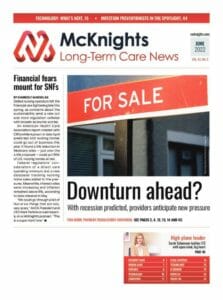When we chose the cover photo — a dramatic “For Sale” sign set against a sad looking building — for our current print magazine, I was afraid it might be a little melodramatic, maudlin even.
Due to our production schedule, we’re often forced to forecast national tone well in advance. But, boy, it sure feels like we hit the nail on the head this time.
Since we pushed print on the June issue, we’ve seen inflation continue to climb, stocks tumble into bear market territory and hints at federal interest rate hikes that will feel aggressive after a decade of steady, historically low rates for borrowers.
And the bad news just continues to mount. The American Health Care Association last week released results of a new survey showing one-third of providers said their staffing woes have gotten “much worse” since January. Almost three quarters (73%) said they were somewhat or very concerned that they might have to close their facilities if workforce challenges persist.
We’re reporting on closures from left coast to right coast, and now there’s news that public receivership could be on the rise, too. In the most recent case, resident care doesn’t appear to be a reason for intervention. Instead, it’s a facility’s inability to pay staff that raised red flags.
For some of us in the right age bracket, all of this bad economic news means that we’ll play the long game and try to stay patient. We might even see a rush among some personal investors to buy low as a means to sell high later. Or at least buy low, then hold on for a good long-time while the market recovers.

But what does it all mean for the nursing home sector? Holding on right now is already possibly as hard as it’s ever been.
A bad economy could turn into a buyer’s market for business-minded investors. Opportunity. That’s what Bill Kauffman, principal at the National Investment Center for Seniors Housing & Care, said some operators see despite the current headwinds of staffing and inflation.
To me, the concern is who those operators might be. We’ve seen plenty of long-time industry players, including the Evangelical Lutheran Good Samaritan Society and Cleveland’s historic Eliza Bryant Village, having to close doors. And for-profit organizations are in some cases shedding or repurposing their skilled holdings, even as occupancy rebounds a smidge.
Are we to believe that if they can’t make it, new folks moved to seize opportunity by market volatility will be able to waltz in and right the ship?
I don’t think that’s what Kauffman’s implying, but I think it’s going to be increasingly troubling for cash-strapped, challenge-laden providers to be viewed through the prism of investment opportunity.
The need for skilled care will no doubt still be there when this downturn we’re sliding into so gracelessly starts to gain upward momentum again.
“The growing need to care for the very frail older adult population that has multiple illnesses, and needs 24-hour care, is where skilled nursing properties must be a solution for years to come,” Kauffman noted. “The question is, will the country ensure this need is met with improved staffing, innovation, and operational infrastructure.”
In the current state of affairs, my thinking is no. We’re hearing from too many operators working in negative margins (and from providers forced to give up after seemingly noble efforts) to make this appear an easy slim-down-and-shape up endeavor for turn-around teams.
And given the regulatory stance of the current administration, there’s not much incentive for certain investor types to come calling right now. That could leave a massive void that overwhelmingly invites unscrupulous investors looking to play the short game.
And that could mean more facilities gobbled up and churned back out, with too little left to restore for the next generation of residents.
Kimberly Marselas is senior editor of McKnight’s Long-Term Care News.
Opinions expressed in McKnight’s Long-Term Care News columns are not necessarily those of McKnight’s.



